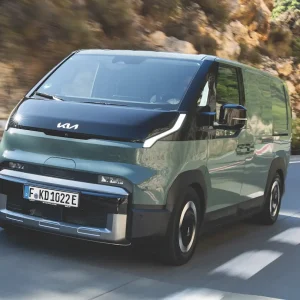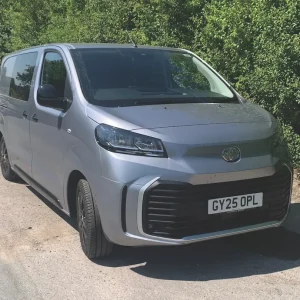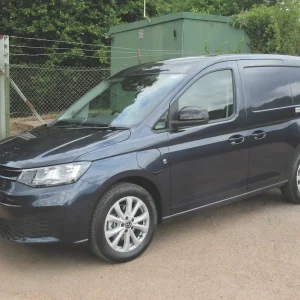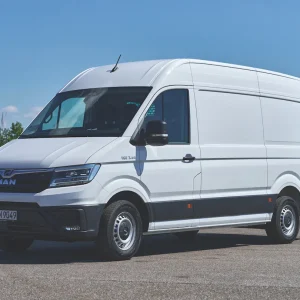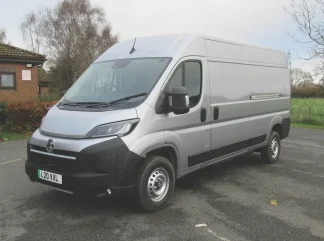
Van manufacturers are practically tumbling over themselves in their eagerness to promote the virtues of going electric. In almost all cases their publicity material spotlights their battery-powered models, with diesel versions pushed unceremoniously into the shadows.
Partly, it’s because they understandably wish to recoup the substantial investment they have made in electric technology. The key driver, however, is that they fear the substantial fines that could be imposed on them by the government’s ZEV (Zero-Emission Vehicle) mandate.
It sets an electric new van sales target of 16% this year, up from 10% last year and rising in incremental steps to 100% by 2035. While the government may be softening its approach a little given global economic turmoil, van producers that breach the target face a fine of £15,000 for every non-compliant diesel or petrol van sold.
European van manufacturers face an additional problem. Chinese electric van producers are increasingly making their presence felt, with Maxus already a well-established player, and newcomers such as Farizon certain to have an impact too.
It was with these considerations in mind that we got to grips with Vauxhall’s Movano Electric van. Sold with two different lengths and two different heights, and in glazed van and chassis cab guise, it comes with a 205kW/279hp electric motor – so it is not short of power.
Vauxhall is part of the Stellantis group, whose roster of brands also includes Citroen, Peugeot and Fiat Professional.
The three brands sell their own, rebadged version of the Movano Electric. Citroen’s is the e-Relay, Peugeot’s is the E-Boxer, while Fiat Professional’s is the E-Ducato.
A joint venture with Stellantis means that Toyota markets a version too under the Proace Max Electric banner.
The Movano Electric we sampled was an L3/H2 with a 13m3 load area. Categorised as an N1 model, it grosses at 3.5 tonnes and can only handle a modest 710kg payload. It can tow a braked trailer grossing at 2,400kg, but remember that hauling a trailer is likely to reduce your range drastically.
The same model is also available in N2 guise grossing at 4.25 tonnes, and can shift a more generous 1,460kg.
Built with two different lengths and two different heights, the 4.25-tonne Movano Electric van is further sold as an L3/H3, an L4/H2, and an L4/H3 with load cubes of up to 17m3. It is also produced as an L4/H2 glazed panel van and as a chassis cab.
Our demonstrator was in Prime trim, the sole level of trim available.

Load bay
Twin rear doors and a sliding nearside door provide access to the cargo area, and the door apertures are commendably wide and high. The back doors can be swung through 90 degrees, and through 180 degrees if you release the stays.
At 557mm, the rear loading height is commendably low, but we still think that grab handles for easier entry would make sense for both the rear and nearside door apertures.
Eight tie-down points are set into the floor, and you will find two more at the base of the full-height steel bulkhead. There are a further three at waist level on the offside plus two more at waist level on the nearside.
With that many lashing points, there is no excuse for failing to secure cargo properly.
A shelf above the cab accessible solely from the load area is a handy place to store restraint straps.
With protective hardboard panels fitted solely to the back doors and the rear door, and nowhere else, our demonstrator’s load bay was lamentably exposed to scratches, scrapes and dents and desperately needed timbering out. The wheel boxes looked especially vulnerable.
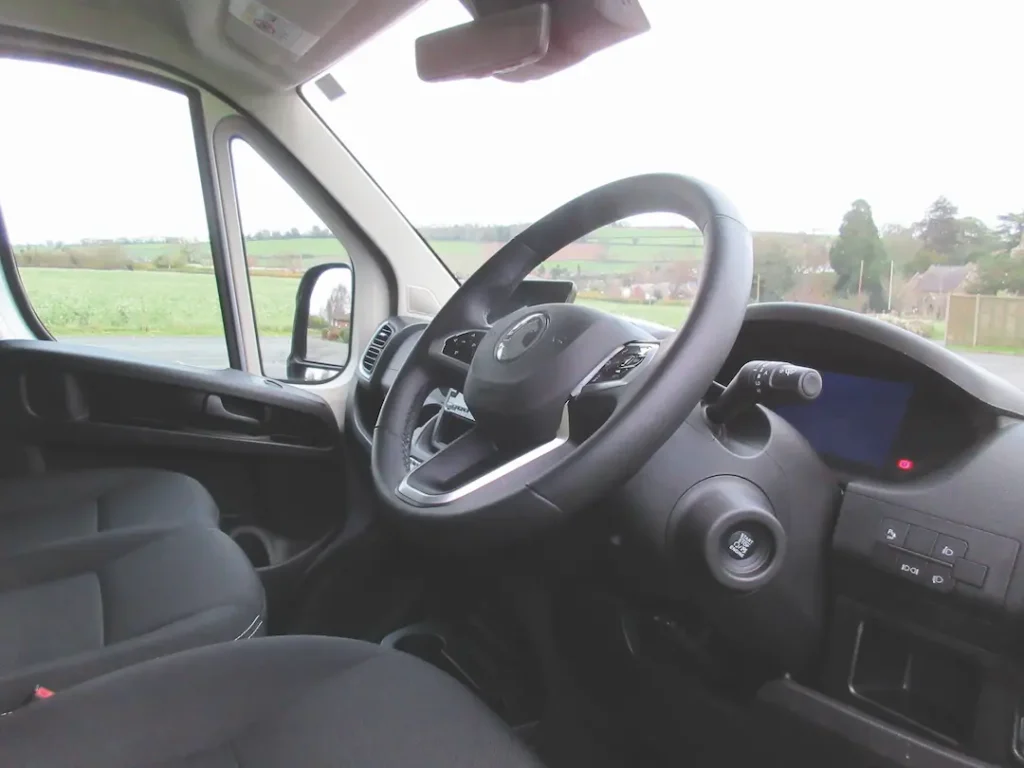
Interior and equipment
The cab interior leaves you with the (not-entirely-inaccurate) impression that offering the Movano with an electric powertrain came as a bit of an afterthought, and the quality of the switchgear and plastic trim is not of the highest. That said, what you get for your money is a reasonably-habitable working environment with plenty of useful features.
The Movano Electric comes with an electronic parking brake and a push-button starter. You turn a knob on the dashboard to select P for Park, R for Reverse, N for Neutral or D for Drive.
A button next to it allows you to choose different drive modes. Normal is adequate most of the time, but you can opt for Power if you need to nip past a queue of slow-moving traffic when it is safe to do so, or Eco if you want to maximise the vehicle’s range.
The dashboard is dominated by a 7in touchscreen. Happily, conventional switches controls the heating, ventilation and automatic air-conditioning, among other functions, and a good old-fashioned knob is used to switch the radio on and off, and alter the volume.
As a consequence, the driver doesn’t need to spend ages prodding the screen simply because they want to turn up BBC Radio 4 or Times Radio, although as it happens the screen is far more user-friendly than many we have encountered.
A DAB radio is included in the deal as are Bluetooth connectivity, Apple CarPlay, Android Auto and voice control. Vauxhall Connect hopefully gives you rapid access to emergency support in the event of an accident.
The 7in digital instrument cluster shows the level of charge left in the battery plus the all-important remaining range.
Our demonstrator came complete with an extra-cost City and Visibility Plus pack which includes a digital rear view camera along with other useful features, including a 230v power point and LED headlights. When you are driving, a camera in the third rear brake light projects a view of what’s behind you onto a screen which substitutes for the rear-view mirror, delivering a clear image.
Fitted too are cruise control, electric windows and electrically-adjustable, heated exterior mirrors with a wide-angle lower section. Cast your eyes around the dashboard and you will locate a 12v power point plus two USB ports.
Parking sensors along with a reversing camera should hopefully ensure that you don’t bash into anything – or anyone – during low-speed manoeuvring.
It’s a three-seater cab, and legroom for the middle passenger is restricted. On the other hand, the amount of storage space for all the odds and sods drivers haul around with them is pretty generous.
There are two roomy bins with a moulding sculpted to accommodate a flask or a bottle of water plus two small shelves in each of the doors. Other stowage facilities include a lidded, but not lockable, glove-box with a shelf above it and a lidded tray above that.
Three shelves are positioned on top of the fascia, with another shelf just below the heating and ventilation controls.
You’ll find a smartphone holder and a couple of cup-holders on a moulding that projects from the bottom of the dashboard – one of the reasons why the middle passenger’s leg space is compromised.
Pull down the centre section of the middle seat’s back and it turns into a desk with a clipboard to keep paperwork tidy plus two more cup-holders.
Including lumbar adjustment and an armrest, the driver’s seat is height-adjustable. So is the steering wheel, and paddles on each side of the steering column allow you to increase (or decrease) the level of regeneration; the amount of kinetic energy that would otherwise be lost when you take your foot off the accelerator and the van slows down.
The energy is pumped into the battery, and boosts your range, with four different levels of regeneration available.
Another feature designed to help increase range is an aerodynamic kit made up of a spoiler and an active grille shutter.
Onboard safety systems include ABS, Electronic Stability Control, Advanced Emergency Braking System and Intelligent Speed Assist, which automatically sets and adjusts your speed to keep you a safe distance from the vehicle ahead.
Lane Support System is there to stop you drifting out of your lane on the motorway, while Traffic Sign Recognition alerts you to the speed in force on the road you are heading down.
Driver and passenger airbags are provided, just in case.
Our van’s 16in steel wheels were shod with Nexus Roadian GTX 215/75 R16 tyres. A pressure monitoring system watches over them.
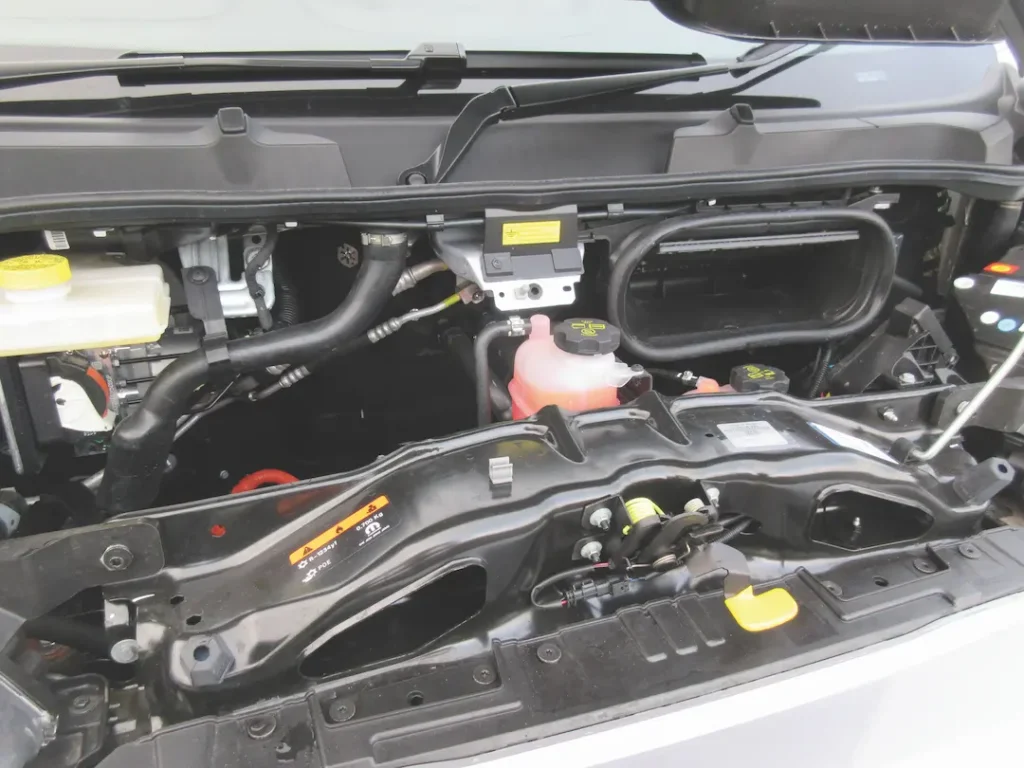
Powertrain
Linked to a single-speed automatic gearbox, the electric motor delivers 410Nm of torque and draws power from a 110kWh battery. An 11kW onboard charger was fitted to our test van, but a 22kW charger is now standard.
That cuts charging time if you are using a three-phase wall-box from 11 hours and 45 minutes to six hours and five minutes, Vauxhall claims. Plug the van into a 150kW DC rapid charger then you can achieve a 0% to 80% charge in 55 minutes, it adds.
Driving
The Movano Electric’s ride is mediocre, especially when lightly-laden, and the handling is by no means exceptional. A better level of response from the steering would be appreciated when demanding bends are being tackled, but the level of assistance it delivers is more than welcome during low-speed manoeuvring.
We found that the Normal drive mode was fine for most eventualities, but the vehicle made heavy weather of some of the steeper hills we encountered in Gloucestershire’s Forest of Dean, even though it was only half-laden. We had to switch to Power to maintain momentum, even though that meant we would end up draining the battery more quickly.
At least making full use of the aforementioned regeneration paddles puts some charge back in when you’re going back down those hills.
Eco is okay if you are lightly-laden and travelling along flat roads with next to nothing in the back, and helps maintain the range, but you lose out on performance. Switch to Power mode if you need to overtake slow-moving traffic and you’ll whistle past.
As for in-cab decibel levels, wind and tyre noise that would be drowned out by a diesel van’s engine become a lot more noticeable when all it is challenged by
is the muted whir of an electric motor; but that’s a characteristic of all electric light commercials.
Having a camera-generated image of what’s happening behind you when you are driving is still a novelty. It’s distracting for the first few minutes, but you quickly get used to it.
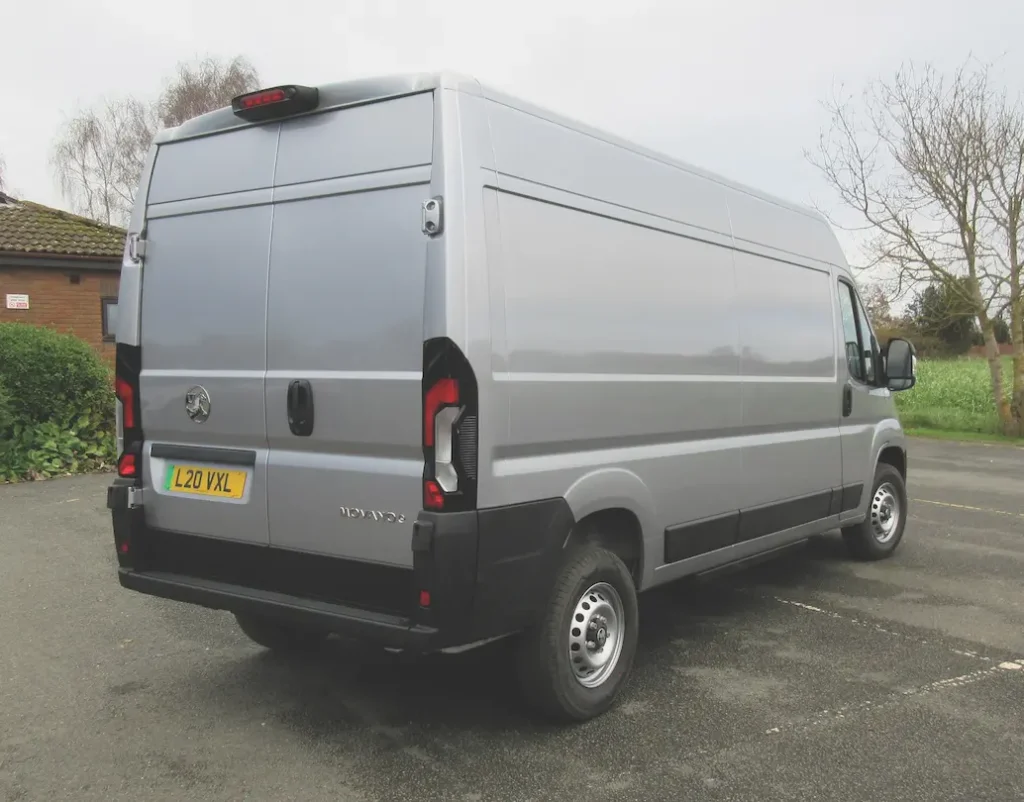
Operating
Our Movano Electric would not engage with the writer’s domestic 7kW AC charging point. When we plugged it in, a warning notice appeared on the dashboard stating that the onboard charging system required a service, and as a consequence we couldn’t replenish the vehicle’s batteries.
We tried two different charging cables, but to no avail.
Refusing to be daunted, we drove the van to a fast DC charging point a couple
of miles away. It was happy with that, and we were able to recharge the batteries fully, but at an eye-watering cost.
Moral? If you are going electric, then make sure you have your own charging facilities and that your chosen van is happy with them, and avoid using public charging points if you possibly can.
The quoted WLTP (Worldwide Harmonised Light Vehicle Test Procedure) combined range is 235 miles, although this is likely to be affected significantly by payload, driving style and temperature. We’d be confident about deploying this vehicle within a 50 to 60 mile radius of home base throughout the year without getting too fearful that we’d run out of steam before we got back to our own charging point.
Vauxhall is addressing any concerns businesses might have about range by introducing hydrogen fuel cell Movanos. They are around £15,000 more expensive than their battery-electric counterparts however – but where do you find clean, green, sustainable hydrogen?
Movano Electric service intervals are set at one year/16,000 miles – short, but the van seems unlikely to cover high annual mileages – and the vehicle comes with a three-year/100,000-mile warranty. That increases to eight years/100,000 miles for the battery with the warranty kicking in once the battery has fallen below 70% of its initial capacity.
Exterior side rubbing strips should hopefully protect that expensive optional quartz silver metallic paint from minor damage. Good to see that our demonstrator boasted a spare wheel, but it too was an extra-cost option.
| Model | Vauxhall Movano Electric Prime L3/H2 |
| Price (ex VAT and PIVG) | £50,385 |
| Price range (ex VAT and PIVG) | £50,385–£52,815 |
| Gross payload | 710kg |
| Load length | 3,705mm |
| Load width (min/max) | 1,422mm/1,870mm |
| Load bay height | 1,932mm |
| Load volume | 13m3 |
| Loading height | 557mm |
| Rear door aperture | 1,562mm x 1,790mm |
| Side door aperture | 1,250mm x 1,755mm |
| Gross vehicle weight | 3,500kg |
| Braked trailer towing weight | 2,400kg |
| Engine size/power | 205kw (279hp) electric motor |
| Torque | 410Nm |
| Gearbox | 1sp |
| Range (combined WLTP) | 235 miles |
| Battery | 110kWh |
| CO2 | 0g/km |
| Warranty | 3yrs/100,000 miles (battery 8yrs/100,000 miles) |
| Service intervals | 1yr/16,000 miles |
| Insurance group | 39E |
| Price as tested | £53,165 |
| Options | Metallic paint (£800), City and Visibility Plus pack (£1,800), full-size spare wheel (£180) |
Rivals

Ford E-Transit
Nobody ever got shot for buying a Transit and that old saying is as true for this model as it was for previous offerings. Two different motors are up for grabs, with no lack of torque, and the selection of electric vans, double-cab-in-vans and chassis cabs is undoubtedly impressive. You’ll find Ford dealers everywhere and residual value are unlikely to be an issue.
| Price range (ex VAT and PIVG) | £49,545–£63,635 |
| Load volume | 9.5-15.1m3 |
| Gross payload | 790-1,758kg |
| Electric motor | 135kW, 198kW |
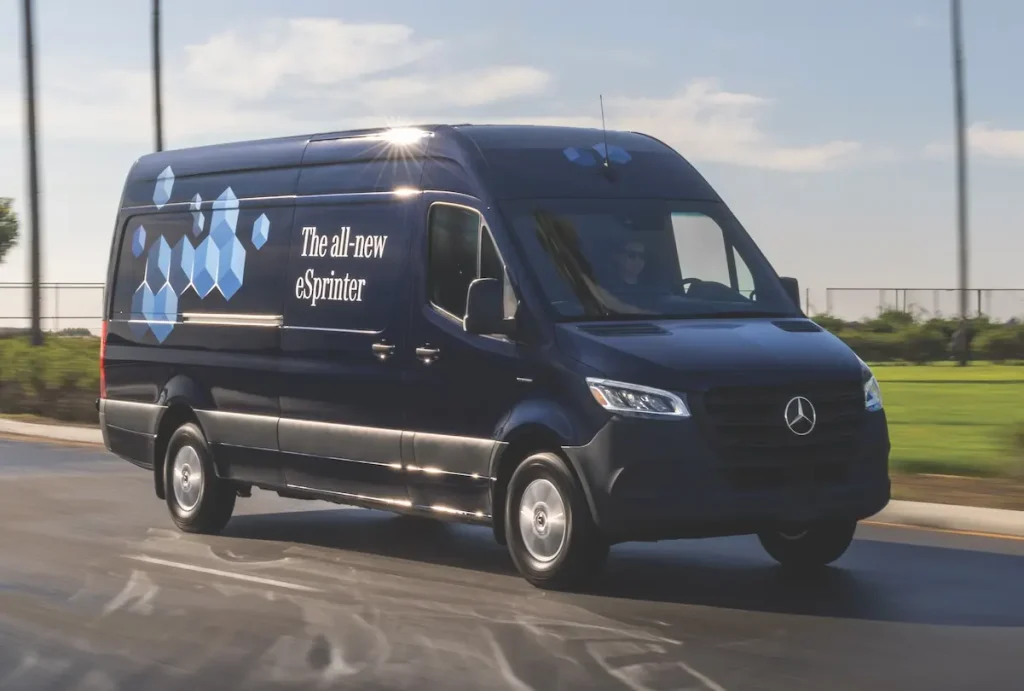
Mercedes-Benz eSprinter
Representing a major step forward, the latest iteration of eSprinter offers a far-better range than its inadequate predecessor. You get to to pick from two different motor power outputs, two battery sizes, three driving modes and a regeneration system that employs steering wheel paddles. It’s pricy, though, and payload capacities aren’t that great.
| Price range (ex VAT and PIVG) | £59,915–£76,920 |
| Load volume | 9-14m3 |
| Gross payload | 490-1,273kg |
| Electric motor | 100kW, 150kW |
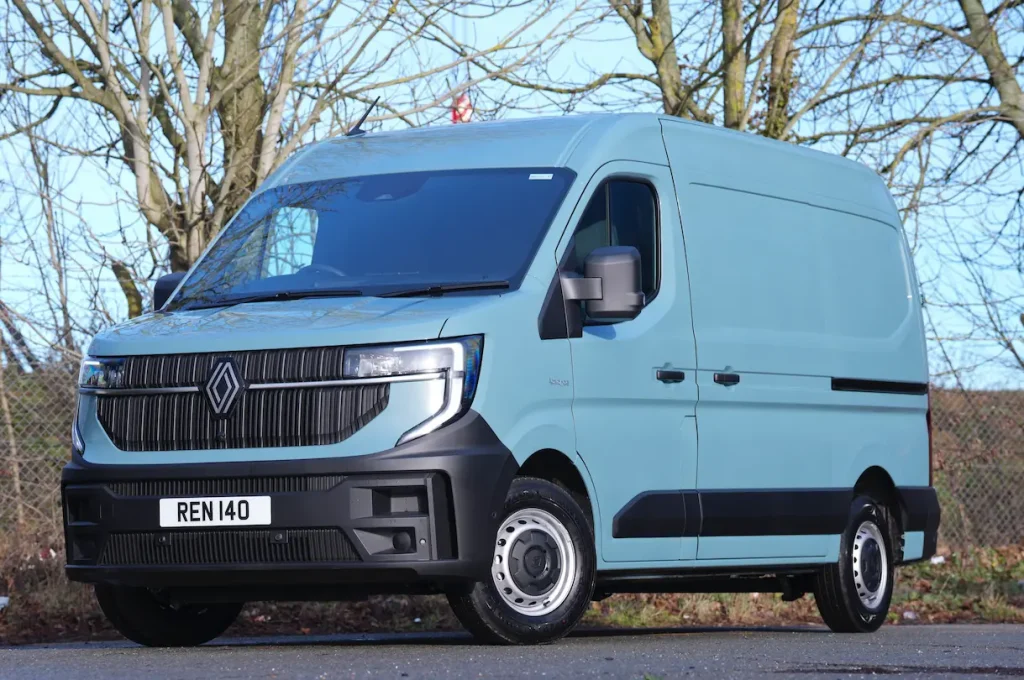
Renault Master E-Tech
A big improvement on previous electric Masters, and offered at extraordinarily competitive prices, the latest version boasts a more-than-respectable range, better aerodynamics, enhanced regeneration and a greatly-improved cab interior. The changes helped make the totally-redesigned Master What Van? Van of the Year for 2025. Remember that it is available through Renault Truck dealers as well as through the Renault car and van network.
| Price range (ex VAT and PIVG) | £42,500–£46,250 |
| Load volume | 10.3-13m3 |
| Gross payload | 957-1,538kg |
| Electric motor | 105kW |
The Final Verdict
| Design | 8/10 | A big battery delivering a respectable range, plus a roomy cargo bay, suggests that this Movano Electric has been designed with all-day urban and suburban parcel delivery work in mind, with the occasional run further afield. If that’s the case, then it ticks quite a few boxes. |
| Cabin | 8/10 | Plenty of storage space and we like the 7in digital instrument cluster, the user-friendly touch-screen, the automatic air-conditioning and the DAB radio. Not the worst place in the world to spend your working day. |
| Ride | 6/10 | Underwhelming, with the umpteen imperfections found in Britain’s road surfaces proving to be a real challenge, especially when the van is lightly-laden. Improves markedly with some weight in the back. |
| Refinement | 8/10 | No squeaks or creaks, which suggests a decent standard of build quality, and while some wind and tyre noise found its way into the cab, it wasn’t that intrusive. |
| Load area | 7/10 | Easy to access with plenty of space and ample cargo tie-down points. Payload capacity is meagre, and you’ll have to step up to a 4.25-tonne model if you need to shift some weight, although that’s not an issue if you’re on parcels work. |
| Handling/performance | 6/10 | The former cannot be classed as outstanding, and the steering response definitely requires tightening up. However, the beefy electric motor packs plenty of punch, especially in power mode. |
| Motor/transmission | 8/10 | As we said, the motor packs punch, but you need to make judicious use of the drive mode switch and the regeneration paddles to get the most out of what it and the battery can offer without compromising the range. |
| Standard equipment | 7/10 | We like the big battery and the onboard safety systems, but you’ll need to resort to the options lists to get all the goodies you might want – and that won’t come cheap. |
| Operating costs | 8/10 | Service intervals are short, but that’s not always a bad thing, and have to be balanced against a decent warranty, and low energy costs if you have your own charging point. |
| What Van? subjective rating | 8/10 | Has its drawbacks, but not a bad package overall. |
| Overall rating | 74/100 |

